Nasal reshaping is the most common type of service provided by plastic surgeons. Many people always perceive even a small defect in the nose as a tragedy. But it can be difficult to decide on surgery - rhinoplasty. Modern aesthetic medicine offers an innovative way to eliminate imperfections. In the presence of minor defects, non-surgical rhinoplasty can improve the appearance and make the face symmetrical.
Types of rhinoplasty
In plastic surgery, it is common to distinguish between several types of rhinoplasty according to the technique and purpose of the operation.
All types of operations are divided into primary and secondary (repetitive), and they can be:
- Reconstructive. This group includes manipulations aimed at restoring anatomical disorders caused by abnormal intrauterine development or as a result of traumatic injuries or diseases.
- Aesthetically. Aimed at correcting shortcomings.
According to what problem needs to be solved, there are many types of rhinoplasty:
- Reduction. Provides a reduction in the size of the osteochondral frame of the nose. This can be shortening of the tip, narrowing of the nasal bridge, the width of the nostrils and lateral cartilage.
- Increase. Aimed at correcting defects by increasing the size of the nasal skeleton. It is also used for secondary plastics.
- Septorinoplasty. Eliminate the curvature of the nasal septum in order to facilitate nasal breathing, including to solve the problem of snoring.
- Transplantation. The required shape of the nose is created by the patient's cartilage tissue. For transplantation can be taken cartilage of the auricle, nasal septum.
- Reconstructive rhinoplasty. Aimed at correcting the results of previous operations.
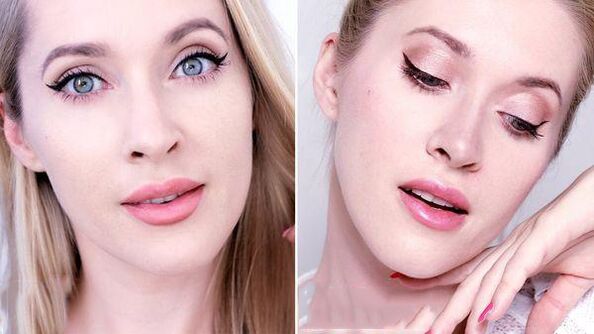
The purpose of the intervention may be a separate hypertrophied nasal mucosa, columella (bridge between the nostrils). Changing the shape of the tip of the nose (removing a hooked or inverted one) is a separate and most difficult type of surgery.
For each correction, the surgeon can choose an operative or non-surgical type of intervention.
Operating room
It is performed under general anesthesia. The duration of the operation can be up to several hours, and the result is maintained for many years. Prior to surgery, the patient must sign a written consent for surgery, which requires careful weighing of the pros and cons and strict adherence to the rules of preoperative preparation, which includes:
- delivery of blood tests, fluorography, electrocardiogram;
- consultation with doctors from other specialties (dermatologist, therapist, psychiatrist);
- adherence to diet.
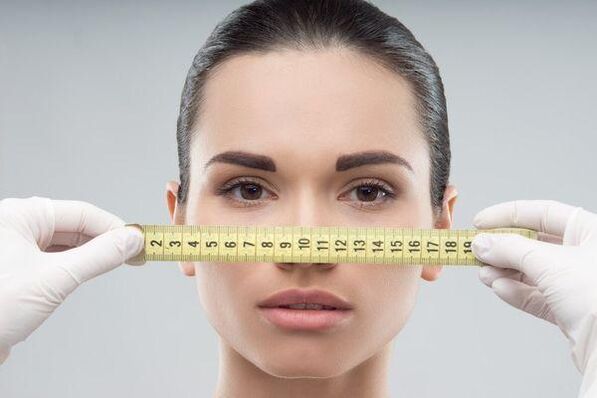
After the operation, the patient was hospitalized for several days under the supervision of medical staff. After discharge, you must also strictly follow some rules and restrictions.
Like any surgery, nose surgery has a number of contraindications and can cause side effects and complications.
Non-surgical
Alternatively, plastic surgery without surgery is used. Contour plastic is minimally invasive and does not involve surgery. It allows you to correct the asymmetry, slightly reduce the tip, remove the hump, straighten the nose, but is not suitable for solving complex problems (restoration of respiratory function, removal of birth defects).
It differs from the classic rhinoplasty:
- the lack of complex surgery and a long period of rehabilitation;
- execution speed;
- short duration of the effect (not more than a year);
- the possibility of re-execution as the result is lost.
This can be injectable plastics using fillers, gels based on hyaluronic acid, hormonal disintegrating drugs or non-injectable correction using sutures or splints.
At the price of contour rhinoplasty is several thousand rubles cheaper than traditional.
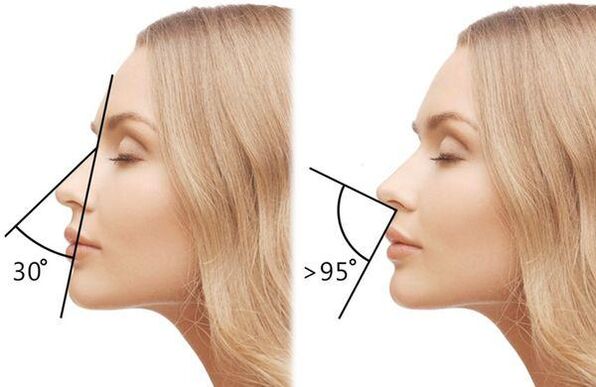
Surgical classifications of rhinoplasty
Primary complete rhinoplasty does not involve an intervention that corrects the entire nose. This is the most popular type of surgery. Conditionally, the indications for surgery are divided into 2 types, in accordance with which the following will be performed:
Cosmetic plastic. If you want to get rid of the following defects in the nose:
- bulge of the back (humps);
- excessive length;
- thickened nose (potatoes);
- saddle back;
- large nostrils.
Functional plastic. Aimed at eliminating defects that lead to poor breathing, prevent the passage of air through the nose:
- injured septum with curvature;
- Narrowing of the nostrils (congenital defect)
- congenital imperfections of cartilage tissue.
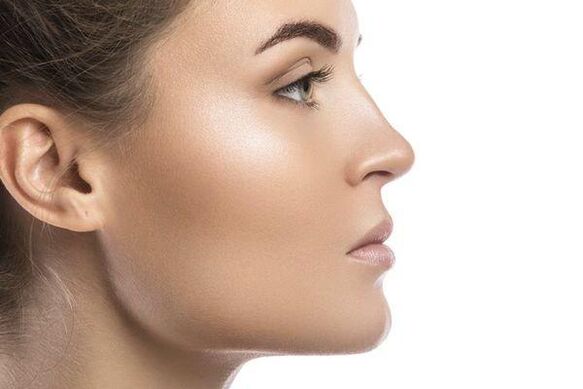
Open up
The technique is used in cases when it is not possible to achieve the assigned task in a closed manner. The incision is made along the columella (the skin part of the fold between the nostrils) and along the wings of the nose, where they join the lip. Open rhinoplasty allows you to lift the soft tissues and cartilage up to gain access to the internal sections for manipulation. Needed for technically complex and large-scale operations:
- severe deformity of the nose, including lateral displacement;
- a combination of nasal deformity with malformations ("cleft lip" or cleft palate);
- reconstruction in which grafts are used.
Disadvantages of this intervention include damage to the arteries of the columella, the formation of a postoperative scar and prolonged postoperative tissue edema.
Repeated rhinoplasty is performed only in an open way. Correcting the shortcomings of primary plastics is a difficult task, which is why an uncompromising aesthetic result is not always guaranteed.
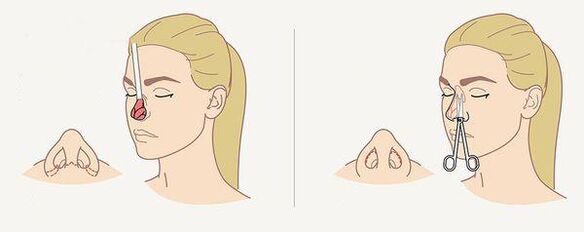
Closed
The method is less traumatic than open. The incision is made from the inside, on the mucous membrane of the vestibule of the nose. Such access is performed when a small-volume operation needs to be performed. This type of intervention is divided into marginal (on the inner surfaces of the wings of the nose), transseptal, inter- and transchondral. An option with closed access is endoscopic rhinoplasty using microinstruments.
Allows to exclude damage to the arteries and malnutrition of tissues, postoperative scars are not visible, as they are located in the nasal cavity, the outer part of the skin remains unaffected. The method is often used for aesthetic operations.
Laser
An operation in which a laser is used to cut tissue instead of a scalpel. The laser incision is more gentle, as the parallel burning of the vessels excludes the development of bleeding.
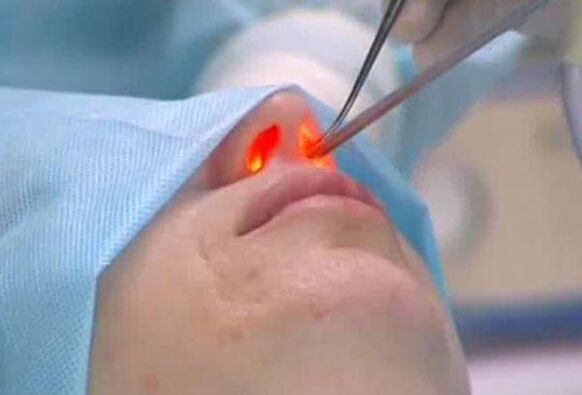
There are 2 types of laser rhinoplasty:
- open, which involves dissecting tissue before modeling the soft part or cartilage base;
- superficial - no incisions are made in the skin, but evaporation of the superficial layers to correct small changes in the tissues of the nose.
Injectable reconstructive rhinoplasty
Sometimes those who decide to undergo rhinoplasty surgery want not only to predict and develop a model, but also to see the end result. The contour injection procedure of the nasal plastic can help with this. The result is faster, more convenient and cheaper.
You can inject drugs repeatedly. In some cases, fibrous tissue forms at the injection site and the nose may take a long time to form.
Hyaluronic acid injections
The effect of hyaluronic acid injections lasts for about six months. The introduction of drugs allows you to smooth the surface of the skin and make the nose symmetrical, small irregularities are filled. Hyaluronic acid fillers are used in cosmetic surgery. These agents are classified as biodegradable, ie soluble. Over time, the drug breaks down into safe components - water and carbon dioxide.
Plastic nasal fillers
There are several groups of fillers. Biodegradable, in addition to the above, include:
- based on animal collagen;
- on collagen of human origin;
- on calcium hydroxyapatite;
- on synthetic lactic acid.
These fillers can have a long-lasting effect.
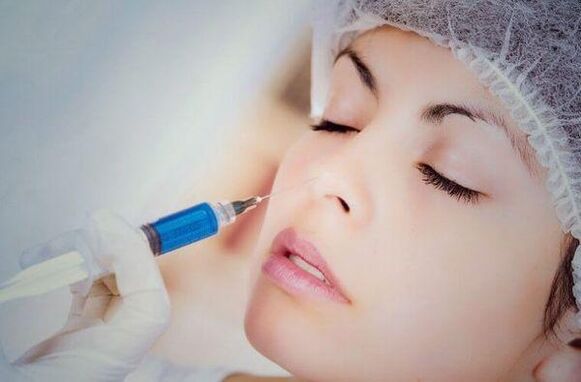
Biodegradable (non-absorbable or permanent) fillers are made on the basis of silicone or other synthetic base (biopolymers). The effect after their application lasts a long time, but experts do not recommend their use. There are several reasons for the failure of synthetic fillers:
- they can cause tissue fibrosis;
- it is impossible to remove them from the body;
- may in the future become an obstacle to operative rhinoplasty.
Hormonal drugs
Glucocorticosteroids, synthetic substances similar to hormones produced by the human adrenal cortex, are used to correct some imperfections in the nose. They are able to soften and partially dissolve cartilage tissue, which makes it possible to correct the shape of the wings and tip of the nose to smooth the hump.
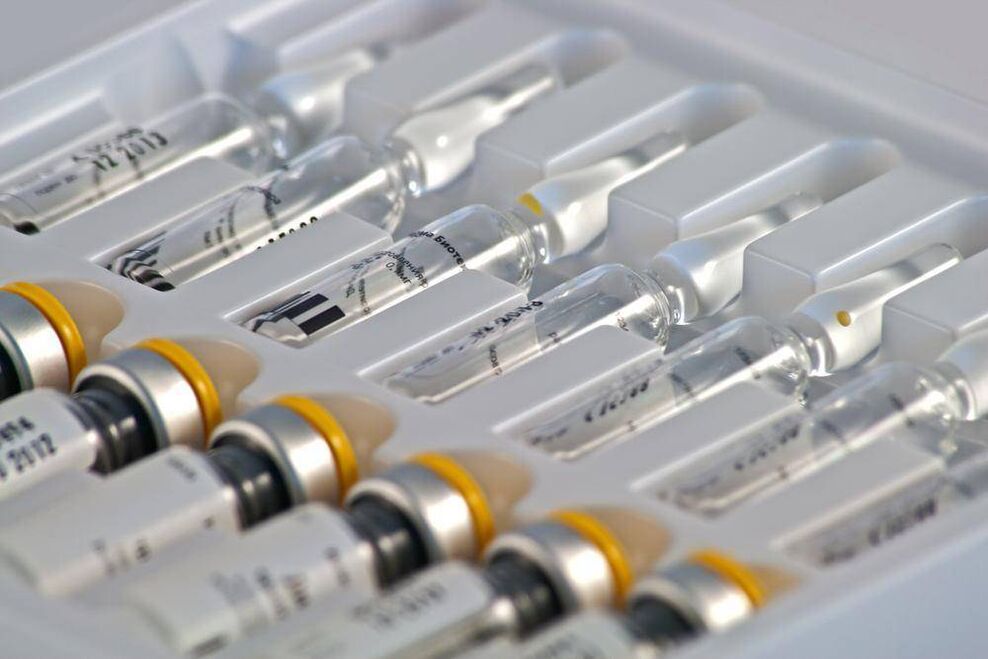
The procedure is relatively easy to perform, but difficult to prepare: it is necessary to very accurately calculate the dosage and depth of application of the drug to avoid asymmetry and the formation of unnecessary cavities in the nose. In addition, excess hormones can cause uncontrolled tissue atrophy.
Most often, such an adjustment is made in courses of several procedures.
Lipolytics
Lipolytics are agents used for mesoinjections. It is a biologically active material that promotes the burning of subcutaneous fat. Dermaheal is used to correct the shape of the nose. Helps to remove wrinkles and creases, will get rid of the "fleshy" nose. Contains active ingredients: phosphatidylcholine, hyaluronic acid, carotene and others.
Non-injection rhinoplasty
Much less often, nose correction is done without injections. Experts believe that such procedures are not effective enough.
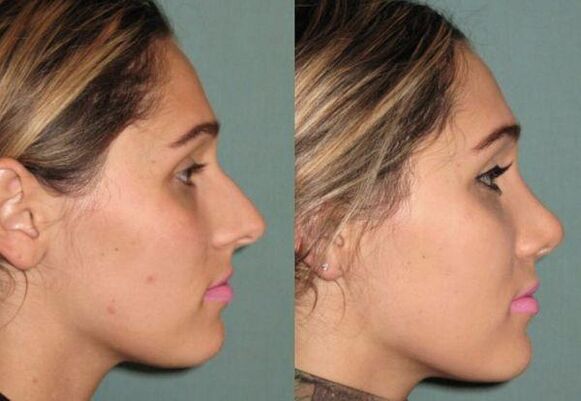
With tongue attached
To align the back of the nose and the tip of it, use a splint - a device made of plastic or plaster. The design puts constant pressure on cartilage and soft tissues and changes their position over time. With the help of a splint you can lift the tip, narrow the wings, reduce the length (by lifting the tip), smooth the hump and restore symmetry.
Nowadays, light mobile structures in the form of clamps or clips are spread. They should be worn every day for several months.
Threads
To eliminate asymmetry, straighten the back, adjust the wings and tip of the nose, use filamentous rhinoplasty. The correction technology consists of inserting strong self-absorbing fibers under the skin. Unlike fillers, the nose does not enlarge visually after thread placement. The result lasts 3 years.
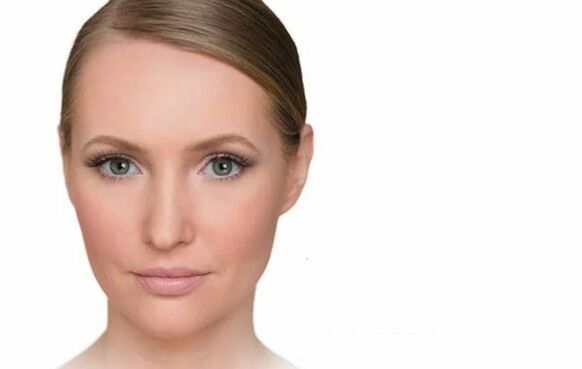
The bionic fibers are made of caprolac and fix the tissues of the nasal area through multiple grooves. The sutures are inserted through small holes, after which the beautician tightens them and gives the desired shape to the nose area. The result becomes obvious after 2-3 days. Other advantages of using threads:
- low invasiveness;
- painlessness;
- the use of local anesthesia;
- no complications;
- no swelling and bruising.
Disadvantages of this method of correction:
- scars may appear at the puncture site;
- the threads can be contoured, ie they will be visible.
The procedure is contraindicated for people with thin fair skin and those who tend to form keloid scars.
Indications for the procedure
When the shape and size of the patient's nose are satisfied, the doctor will most likely prescribe a procedure without performing surgical procedures. You can do without a scalpel when adjusting details to get rid of:
- from the asymmetry of the nose;
- from dents, dips, dents and bumps;
- from the drooping tip of the nose;
- from the hump;
- from a flat upper back;
- from sagging skin near the nose.
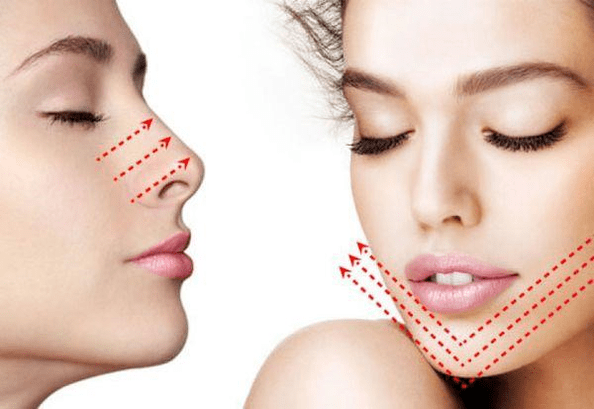
Such a procedure is also used as a temporary measure in case a minor patient with severe disabilities (as a result of a fracture or injury) cannot be operated on.
In men
Men prefer a radical approach to filler modeling to get rid of blemishes once and for all. Indications for rhinoplasty in men can be:
- frequent sinusitis, chronic nasal congestion;
- injuries leading to deformation of the nose and its septum;
- congenital pathologies and deformities in the bone structure of the organ;
- saddle shape, large nostrils, wide bridge of the nose, large length or thickness of the nose;
- breathing disorders;
- the presence of an ugly hump.
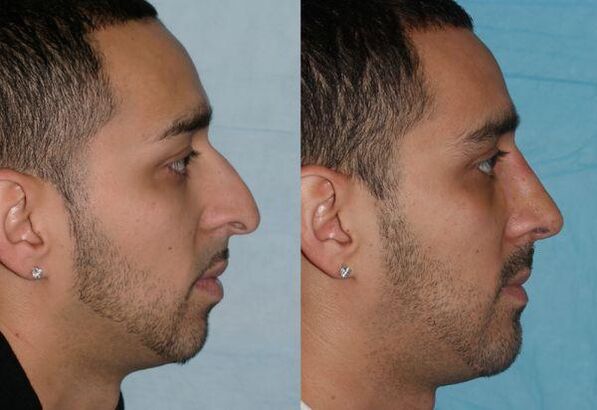
Among women
Any type of intervention can be used in women. Which one to resort to, the surgeon decides. If small changes need to be made, then the aesthetic problem will be solved without the use of a scalpel. The injection method is often used on the eve of surgery so that a woman can assess what her nose will look like in the future.
What can be fixed with this procedure
Back correction
The reduction is achieved by injecting a filler into the curved part. To correct the hump, the gel is injected along the entire length of the spine of the nose. Absorbent preparations with hyaluronic acid are most often used to straighten the nose.
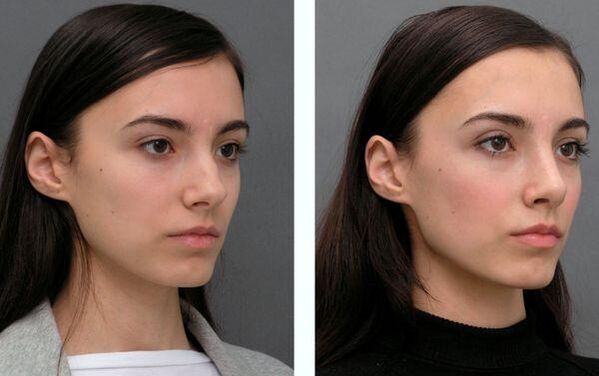
Tip correction
It is performed by injecting fillers into the problem areas. Such rhinoplasty is especially sought after when there are small pits or depressions on the tip of the nose. The nose of the potato is corrected by inserting a filler at the very tip, which makes it sharper.
The tip can be lifted by injecting the gel into the area of the nasal columella. Visually, this hides the hanging tip. In some cases, an injection into the wings of the nose is needed to slightly shrink the nostrils.
Repairing a broken nose
If the nose has been injured more than once, then the contours will not help. In such a situation, only nasal septum surgery is indicated. And most likely a complete reconstructive and aesthetic operation. Reconstruction of both the septum and the external osteochondral skeleton may be necessary.
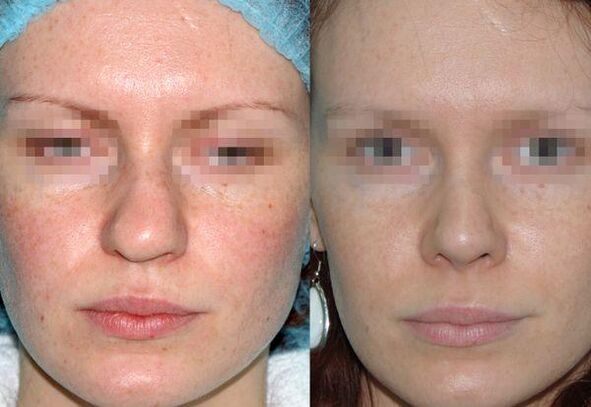
Alignment of the backrest
It is impossible to straighten the curved nasal bridge without surgery. Rhinoplasty by injection only makes it possible to mask the defect. For example, correction of the nose (with a low bridge and a raised tip) is done by injecting fillers over the entire surface of the nasal bridge to the very tip.
Wing reduction
The gel with hyaluronic acid is used to correct the asymmetry of the wings of the nose. In this case, the specialist must accurately calculate the dose.
The nose becomes thinner and more expressive after hormone rhinoplasty.
If it is necessary to remove the asymmetry of the nostrils or reduce it, then the fillers are injected into the lower part of the wings of the nose.
How old is the operation?
There must be clear reasons for facial surgery. The conscientious plastic surgeon will not undertake the correction of the minor's nose if a certain whim of a girl or boy serves as a basis.
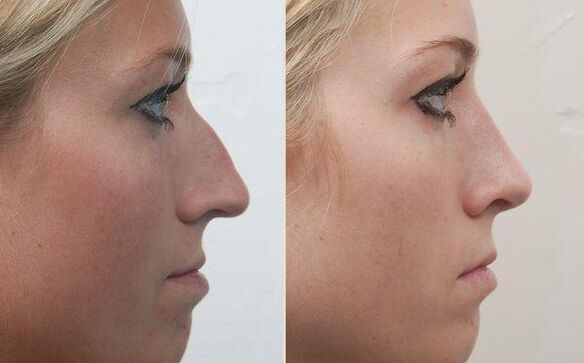
Persons over the age of 18 are admitted to the operation. In extremely rare situations, this condition can be disrupted. The minimum age for rhinoplasty for girls is 13-14 years, for boys - 15-16 years.
For medical reasons, a teenager can undergo almost any plastic surgery. However, doctors recommend that you be patient until the age when the operated organ is formed by at least 80-90%.
How is the preparation for the non-surgical procedure
Unlike classical surgery, it is easier to prepare for a non-surgical procedure. Perhaps your doctor will advise you to consult a dermatologist, to tell you what tests are done to identify contraindications and limitations.
Adherence to the following rules will help reduce the risk of complications:
- 10 days before plastic surgery you should stop drinking alcohol;
- salicylates increase bleeding, which means that a week before the procedure you should stop taking "Aspirin" and other similar drugs;
- refrain from eating at least 10 hours in advance;
- a few days before the injection plastic is recommended to exclude high physical activity;
- it is necessary to wash your hair the day before, as you can not bend down and wet your face after the procedure.
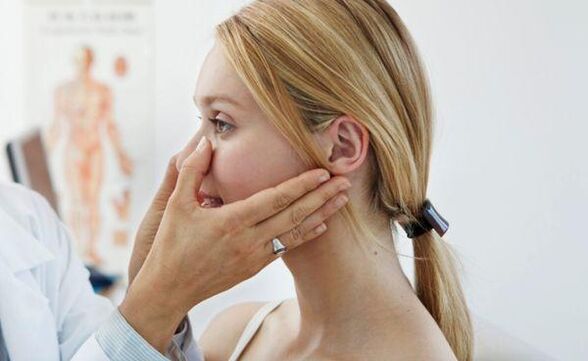
The doctor prescribes antihistamines. In case of fever, menstruation, respiratory diseases, the procedure will have to be abandoned until recovery.
Do I need anesthesia
No general anesthesia is required for non-surgical rhinoplasty. Topical or infiltration anesthesia is used for anesthesia.
Performing technology
Non-surgical plastic surgery is performed on an outpatient basis, there is no need for hospitalization of patients. After the procedure, the plastic surgeon's clients go home.
A thorough examination and computer modeling of the future shape of the nose is performed in advance. The average duration of the manipulations is 35-60 minutes. The operation continues step by step as follows:
- The patient is conscious, only local anesthesia is used. The doctor applies a lidocaine-based cream to the nose and the area around it. The exposure time under the film is 10-15 minutes.
- After opening the ampoule with the drug and filling the gel into the microcannula, gradually and carefully inject the filler into certain areas of the nose. If the client wishes, he can observe the progress of the process with the help of a mirror, which he will hold himself.
- If necessary, the beautician can re-infuse the filler.
- The last stage is a light hand massage. Needed for better filler distribution.
The result can be evaluated immediately. The fillers are safe and completely absorbed within 1, 5 years.
Consequences and contraindications of non-surgical rhinoplasty
No adjustment should be made to women during pregnancy or during menstruation. Non-surgical correction is contraindicated for people suffering from the following diseases:
- acute infectious diseases;
- keloidosis;
- autoimmune pathologies;
- pathologies of the endocrine system, including diabetes mellitus;
- hemophilia and other blood clotting problems;
- allergies and individual intolerance to the components of the drugs used;
- oncological diseases, tumors of any localization.
What complications can occur
Complications after surgery occur in 10% of cases. They can also occur during surgery (bleeding, tearing of the skin, rupture of the mucous-cartilage valve, disruption of the integrity of the bone pyramid, fracture of the bone site).
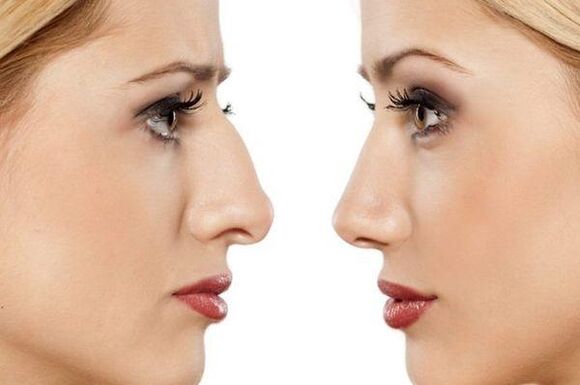
If several cosmetic defects are removed during the operation, a number of complications can develop:
- nosebleeds;
- postoperative pigmentation;
- bone callus;
- swelling and hematoma of the soft tissues;
- loss of odor;
- the appearance of keloid scars;
- difficulty breathing;
- curvature of the nasal septum.
Rhinoplasty without surgery is not so dangerous, although it is also considered a difficult procedure in cosmetic surgery. A special splint is then applied to the patient's nose to fix the result and prevent injury.
For several hours after the procedure, there may be redness and swelling of the skin in the nasal area. These problems completely disappear within 24 hours. After tightening with sutures, bruises can form, which completely disappear within a week.
Rare complications include processes that can occur due to the inexperience of the surgeon performing the procedure, or the patient's failure to follow postoperative rules: displacement of the fillers and rupture of threads placed under the skin. The doctor must deal with the problem urgently.
Nasal care after surgery
Laser rhinoplasty, hyaluronic acid injections and fillers reduce the rehabilitation period to a minimum. You can go home immediately after the nasal contouring procedure. The swelling subsides within 1-2 days.
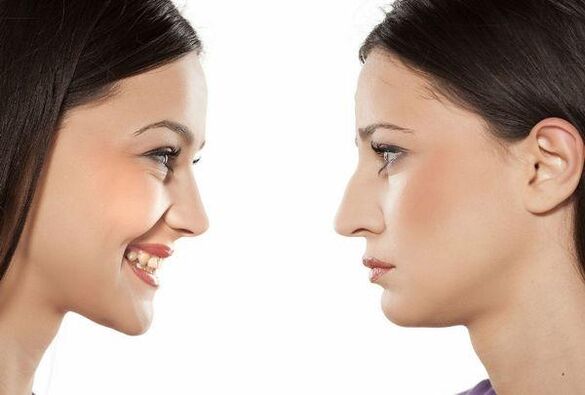
On average, rehabilitation lasts up to several days (depending on the method of correction performed). There are almost no restrictions after the manipulation. You can continue to go to work, play sports and live your normal life.
In the postoperative period it is necessary to monitor facial expressions: you can not squint, frowning. You should not tense your muscles, blow your nose, sneeze or cough for several hours. You should not wear glasses for the first 2-3 days of recovery.
Strict restrictions apply to visits to all places for swimming (lakes, pool, bath, sauna). You also need to give up sunbathing, smoking, the base.
You cannot massage the injection site or perform physiotherapy for 2 weeks.
How long does the swelling last after the operation?
The entire period of rehabilitation after surgery can take about a year. During the first days, the patient should wear a bandage, dressing or cast. The swelling of the face will disappear after 1-2 days. After 21 days, the cast is removed and the blood clots from the nose and tampons are removed.
Active recovery occurs over the next 3 months, traces of side effects disappear, but minor changes may occur by the end of the year.
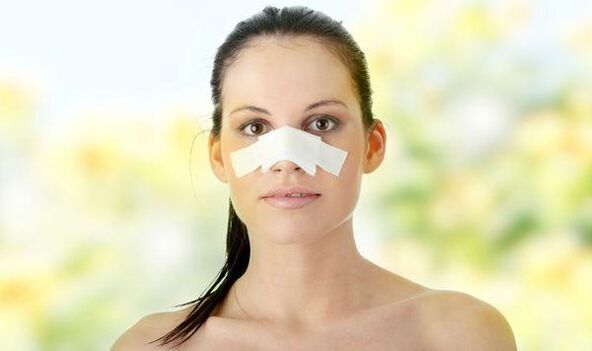
What to do if the operation fails
The result of the operation can be assessed only after 6 months. Practice shows that 20% of all interventions to correct or eliminate defects in the nose are not the only ones.
If after this time the nose does not take the desired shape or swelling remains, then the operation can be considered a failure. In such situations, repeat operations are assigned.
When to repeat the procedure
The effect of non-surgical nasal surgery lasts on average about a year. You can repeat the procedure at any time.
After the operation, repeated (secondary) rhinoplasty can be prescribed not earlier than a year later. Technically, this is a more complex procedure. It is prescribed if the patient is not satisfied with the result or the previous operation was unsuccessful (did not give the expected effect).
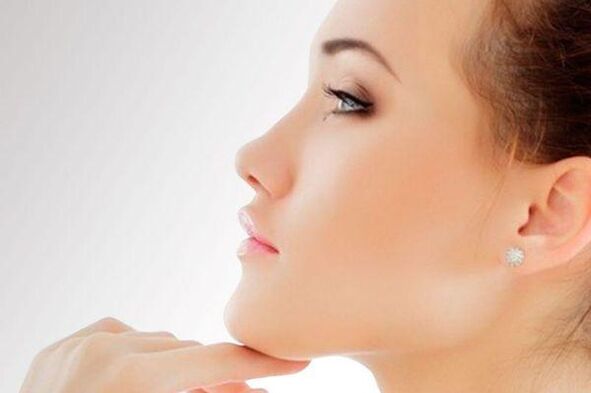
Benefits of non-surgical rhinoplasty
The filling and suturing procedure cannot be considered a complete alternative to surgery, but there are a number of obvious advantages. The main ones are:
- painlessness;
- short period of rehabilitation (sometimes absent);
- rapid achievement of results;
- reversibility (you can always return the previous form if the result is not satisfactory).
The procedure has both pros and cons. It has an extremely low effect on the general condition of the body, does not injure the tissues of the face, after which no scars and scars are formed. But if injected incorrectly, lumps of gel may form under the skin. Their displacement will lead to a change in the shape of the nose.
After minimally invasive intervention there are no stitches, the skin heals better. But the risk of infection and infection still remains.
The low price makes the procedure affordable for anyone who wants to improve their appearance. However, the possible complications oblige to be extremely careful when choosing a clinic.Most often, unsuccessful cosmetic interventions occur after visiting non-specialized salons and doctors who do not have the appropriate qualifications.The final decision should be made only after studying the previous work of the master and the evaluations of the clinic.




















